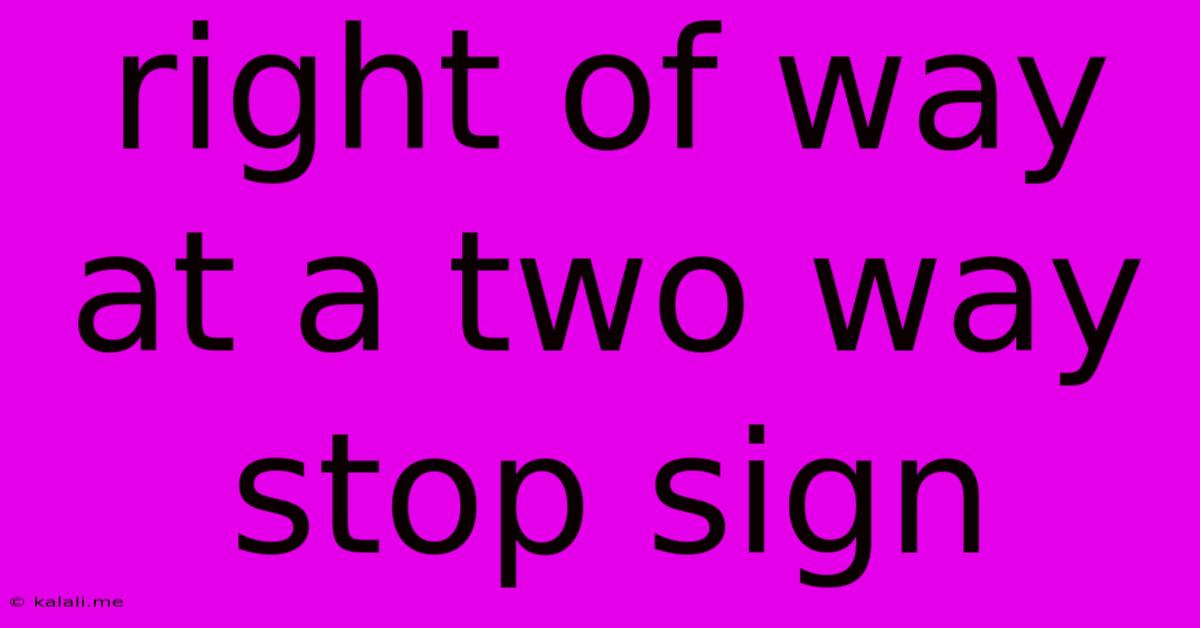Right Of Way At A Two Way Stop Sign
Kalali
May 24, 2025 · 3 min read

Table of Contents
Navigating Two-Way Stop Signs: Understanding Right-of-Way Rules
Understanding right-of-way rules, especially at two-way stop signs, is crucial for safe driving. Failing to yield properly can lead to accidents and frustrating traffic jams. This guide will clarify the procedures and nuances of navigating these common intersections. This information is for general guidance; always refer to your local traffic laws for specifics.
What is a Two-Way Stop Sign?
A two-way stop sign means that traffic on the intersecting road(s) must stop before proceeding. Traffic on the road without a stop sign is generally expected to continue, however, caution is still advised.
Who Has Right-of-Way at a Two-Way Stop?
The general rule is that the first vehicle to stop at the intersection has the right-of-way. This means that if you arrive at the intersection simultaneously with another vehicle, the driver on the right generally has the right-of-Way. However, several factors can influence this:
-
Arrival Time: The vehicle that stopped first has the right-of-way. This requires drivers to be observant and not simply assume they have the right-of-way because they are on the right.
-
Simultaneous Arrival: If both vehicles arrive at the intersection at the same time, the vehicle to the right generally has the right-of-way. This is a common point of confusion, leading to accidents.
-
Yielding is Key: Even if you have the right-of-way, you still have a responsibility to yield to other vehicles and pedestrians to prevent accidents. Never assume another driver will follow the rules.
-
Traffic Flow: If a vehicle is already proceeding through the intersection, you must yield to it, regardless of which side of the road you are on. Prioritize safe merging over asserting right-of-way.
Avoiding Accidents at Two-Way Stops: A Step-by-Step Guide
-
Approach Cautiously: Slow down as you approach the intersection and be prepared to stop. Scan for other vehicles and pedestrians.
-
Complete Stop: Make a full and complete stop behind the stop line. Never simply roll through.
-
Observe: Carefully look left, right, and then left again to ensure the intersection is clear.
-
Check Blind Spots: Before proceeding, check your mirrors and blind spots to ensure you have a clear view of oncoming traffic.
-
Proceed Safely: Only proceed when it is safe to do so. Even if you have the right-of-way, yield to others if necessary to avoid collisions.
-
Be Aware of Larger Vehicles: Trucks and buses require more space and time to stop and maneuver, so allow extra space and time for them to navigate the intersection.
-
Pedestrians Always Have the Right of Way: Remember that pedestrians always have the right-of-way at intersections. Always yield to pedestrians, even if you have the right-of-way.
Common Mistakes to Avoid
- Rolling Stops: Never just roll through a stop sign. A complete stop is mandatory.
- Ignoring Other Vehicles: Always check for other vehicles, even if you believe you have the right-of-way.
- Speeding: Approaching the intersection at a high speed reduces your reaction time and increases the risk of an accident.
- Assuming Right-of-Way: Never assume you have the right-of-way; always check before proceeding.
Mastering right-of-way procedures at two-way stop signs is crucial for safe driving and prevents collisions. By carefully observing the rules and being mindful of other drivers and pedestrians, you can navigate these intersections smoothly and safely. Remember to always prioritize safety above asserting your right-of-way.
Latest Posts
Latest Posts
-
No One Knows The Day Or The Hour
May 24, 2025
-
How To Unclog A Bathtub Drain
May 24, 2025
-
How Many Words In A Chapter
May 24, 2025
-
How To Get A Stripped Bolt Out
May 24, 2025
-
How To Tell If Propane Tank Is Empty
May 24, 2025
Related Post
Thank you for visiting our website which covers about Right Of Way At A Two Way Stop Sign . We hope the information provided has been useful to you. Feel free to contact us if you have any questions or need further assistance. See you next time and don't miss to bookmark.